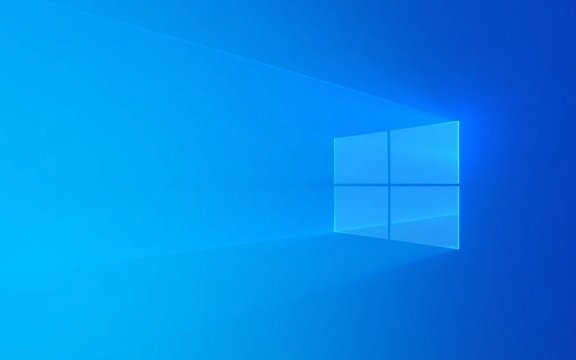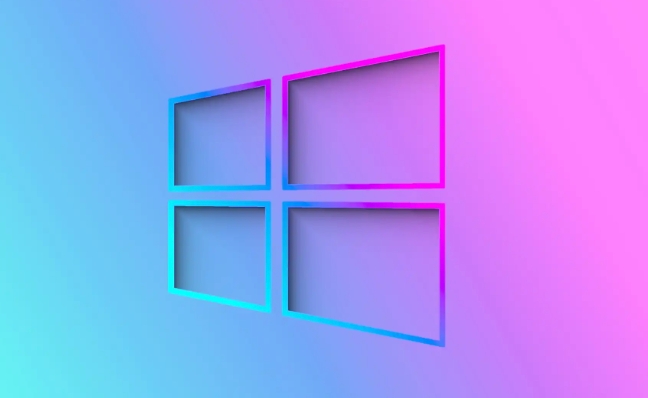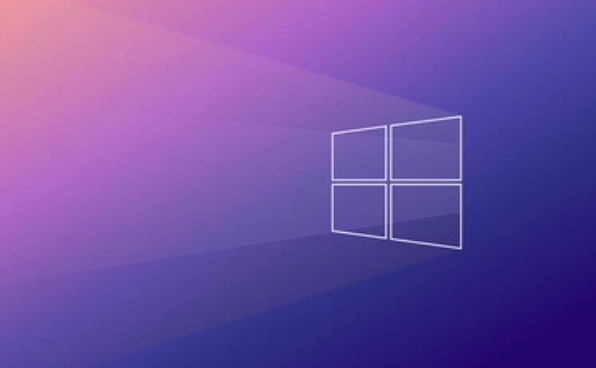To install Windows system, you need to boot through a USB drive. The specific steps are as follows: 1. Prepare a bootable USB drive, use the Media Creation Tool or Rufus tool to make at least 8GB of USB drive into a boot media; 2. After inserting the USB drive, enter the BIOS/UEFI setting interface, and computers of different brands press the corresponding keys such as F2, F10, Del, etc. to enter the settings; 3. Set the USB drive as the first startup item in the Boot menu, or use the shortcut key F12 to temporarily select the boot device; 4. Save the settings and restart the computer, load the installer from the USB drive to start installing the system, note that you may need to manually import the driver to support NVMe or RAID devices. Just follow each step correctly to install Windows successfully.

If your computer needs to install a Windows system, the most common method is to start the installation via USB drive. This process is not complicated, but there are several critical steps that must be operated correctly to successfully boot from USB.

Prepare a bootable USB drive
Before you can boot from a USB drive, you must first make sure that the USB drive itself is a "bootable" installation media. You can use Microsoft's official tool Media Creation Tool to create it, which will automatically download the corresponding version of Windows and format the USB drive to bootable state.

- After downloading the tool, run it and select "Create installation media for another computer"
- Insert a USB drive of at least 8GB capacity
- Follow the prompts to select language, version, and architecture (usually 64-bit)
- The tool will automatically start writing, and after completion, your USB drive will have the ability to start
In addition, third-party tools such as Rufus can also be used, which are suitable for advanced users or have higher requirements for system customization.
Enter the BIOS or UEFI settings interface
After plugging in the USB drive, you need to let the computer know to boot from it first. This requires entering the BIOS or UEFI setting interface to adjust the startup sequence.

Different brands of computers have slightly different ways to enter the settings. Common keys include:
- Dell: F2 or F12
- HP: F10
- Lenovo: F1 or F2
- Asus motherboard: Del or F2
- Apple Mac (installed with Windows): Press and hold the Option key to turn on the computer
When powering on, quickly press the corresponding key to enter the setting interface. Be careful to plug in the USB flash drive to turn on the device.
Adjust the startup sequence and save settings
After entering the settings interface, find the menu of Boot or Startup Options . Here you can see the current boot sequence, and the hard disk is usually ranked first.
What you need to do is:
- Find the device name with the word USB (such as USB Storage Device or specific USB drive brand)
- Use the arrow keys or function keys on the page prompt (such as F5/F6) to move it to the first position in the startup sequence
- Then find "Save and Exit" or similar option to save the settings and restart
Some motherboards also support the quick boot menu (usually F12), and you can temporarily choose which device to boot from without entering the BIOS, which is more convenient for one-time operation.
Start installing Windows
After the computer restarts, if everything is set correctly, the Windows installer will be loaded from the USB drive. Wait for a moment and the familiar installation interface will appear. Then you can partition, format, select the installation location and other operations as prompts.
It should be noted that during the installation process, you may encounter problems such as driver not being recognized, especially NVMe solid-state drive or RAID configuration. At this time, you can click "Load Driver" to manually import the relevant driver files.
Basically that's it. As long as your USB drive is fine and the BIOS is set correctly, you can boot and install Windows from USB successfully. The whole process looks a bit technical, but it is not difficult to operate. The key is not to skip any details.
The above is the detailed content of How to boot from USB to install Windows. For more information, please follow other related articles on the PHP Chinese website!

Hot AI Tools

Undress AI Tool
Undress images for free

Undresser.AI Undress
AI-powered app for creating realistic nude photos

AI Clothes Remover
Online AI tool for removing clothes from photos.

Clothoff.io
AI clothes remover

Video Face Swap
Swap faces in any video effortlessly with our completely free AI face swap tool!

Hot Article

Hot Tools

Notepad++7.3.1
Easy-to-use and free code editor

SublimeText3 Chinese version
Chinese version, very easy to use

Zend Studio 13.0.1
Powerful PHP integrated development environment

Dreamweaver CS6
Visual web development tools

SublimeText3 Mac version
God-level code editing software (SublimeText3)

Hot Topics
 macOS installer is damaged and can't be used
Jun 28, 2025 am 12:01 AM
macOS installer is damaged and can't be used
Jun 28, 2025 am 12:01 AM
When you encounter the prompt "macOS installer is corrupted and cannot be used", the problem is usually not that the installation package itself is corrupted, but that there is an error in the verification mechanism or storage method. 1. Re-download the macOS installer, and priority is obtained from Apple's official channels to ensure integrity; 2. Turn off the installation verification in SIP, enter the csrutildisable command through the terminal and temporarily close the verification and restart the installation; 3. Check whether the USB boot disk is made correctly. It is recommended to use the createinstallmedia command and ensure that the USB disk format is MacOS extension; 4. Correct the time and date settings, adjust the time through the date command in the recovery mode to avoid misjudgment of the certificate expiration. Most of them are after completing the above steps.
 How to partition hard drive for Windows installation
Jun 27, 2025 pm 02:27 PM
How to partition hard drive for Windows installation
Jun 27, 2025 pm 02:27 PM
Partitioning is crucial to installing the system. Good partitioning can improve the system operation efficiency and data management convenience. First of all, you need to know that there are up to 4 main partitions, and logical partitions are required if there are more than UEFI. The new computer recommends that the GPT format be started with UEFI, and the old machine uses MBR; the system disk is reserved at least 60GB. It is recommended that home or office users be divided into 2 to 3 zones: system disk (60 to 100GB for disk C), data disk (remaining space for disk D), optional backup/tool ??disk (approximately 50GB for disk E), dual systems require additional partitions. During installation, operate the partition on the "Custom Installation" page, and be careful to delete the old system partition to avoid confusion. In terms of details, the default NTFS format is maintained, the SSD is turned on AHCI mode, partition first and then install the system, and disk management can be used to adjust the partition size but avoid it.
 macOS installer won't accept my password
Jun 29, 2025 am 12:14 AM
macOS installer won't accept my password
Jun 29, 2025 am 12:14 AM
The answer to the question is that the password error prompt may be caused by keyboard layout, case recognition, or installer source. The macOS installation interface uses an American English keyboard by default. The input of non-English keyboards may not match. It is recommended to switch layouts or avoid special characters; the password is case-sensitive, and it is recommended to check the CapsLock status or try all lowercase; if the installer comes from another Mac, you need to enter the Mac password to make the installer; you can also try to re-download the installer through recovery mode, confirm the administrator account identity, or format the disk with disk tools first.
 How to dual boot Windows 11 and Ubuntu
Jul 01, 2025 am 12:08 AM
How to dual boot Windows 11 and Ubuntu
Jul 01, 2025 am 12:08 AM
When installing dual systems, you need to pay attention to partitioning, installation order and BIOS settings. 1. Partition preparation: Use disk management tools to compress at least 25GB (50GB or more) of unallocated space to Ubuntu without formatting; 2. Make a boot U disk: Use Rufus to write Ubuntu ISO to at least 8GB U disk; 3. BIOS settings: Restart and enter the BIOS (usually press F2, Del or Esc), turn off SecureBoot, and set the U disk as the first boot item; 4. Install Ubuntu: Select "Somethingelse" custom partition, create a new ext4 mount point/ and occupy the remaining space, and build a swap partition equal to the memory size, boot and add
 What is the difference between macOS Recovery and Internet Recovery?
Jul 02, 2025 am 12:24 AM
What is the difference between macOS Recovery and Internet Recovery?
Jul 02, 2025 am 12:24 AM
macOSRecoveryisabuilt-inrecoverysystemonahiddenpartitionofyourMac’sstartupdisk,providingtoolslikeDiskUtility,Terminal,andmacOSreinstallation.1.Itloadsquicklyfromlocalstorage.2.Requiresafunctioninginternaldrive.3.ToolsincludereinstallingmacOS,repairin
 How to install Windows 10 in VirtualBox
Jun 30, 2025 am 12:02 AM
How to install Windows 10 in VirtualBox
Jun 30, 2025 am 12:02 AM
The key steps to install Windows 10 to VirtualBox are as follows: 1. Prepare VirtualBox, Windows 10 ISO images and system resources; 2. Create a virtual machine and set the name, type, memory and virtual hard disk; 3. Mount the ISO file and start the installation process; 4. After the installation is completed, the enhancement function expansion package is inserted to improve performance and operating experience. The entire process requires attention to hardware compatibility, BIOS settings and installation of necessary dependencies to ensure smooth installation.
 Can I use my Windows 7 product key to activate a new Windows 10 installation
Jul 02, 2025 am 12:15 AM
Can I use my Windows 7 product key to activate a new Windows 10 installation
Jul 02, 2025 am 12:15 AM
No,youcannotdirectlyuseaWindows7productkeytoactivateWindows10.1.Windowsproductkeysareversion-specific,soaWindows7keyonlyworksforWindows7.2.IfyourPCwasupgradedfromWindows7toWindows10beforesupportended,itmayhaveadigitallicenselinkedtothehardware,allowi
 Minimum system requirements for Windows 11
Jul 03, 2025 am 12:48 AM
Minimum system requirements for Windows 11
Jul 03, 2025 am 12:48 AM
The minimum hardware requirements of Windows 11 mainly include five aspects: 1. The processor must be from the sixth-generation Intel or Ryzen starting point or above, supports 64-bit, dual-core and above, the main frequency is not less than 1GHz, and is on the Microsoft support list; 2. At least 4GB of memory, but 8GB or higher is recommended to ensure smooth use; 3. At least 64GB of storage space, the system itself occupies about 25~30GB, and it is recommended to use SSD; 4. The TPM2.0 security module must be supported and enabled, many motherboards did not meet this condition before 2016; 5. Some users try to bypass the restricted installation may cause driver or update problems, and ordinary users do not recommend this.






